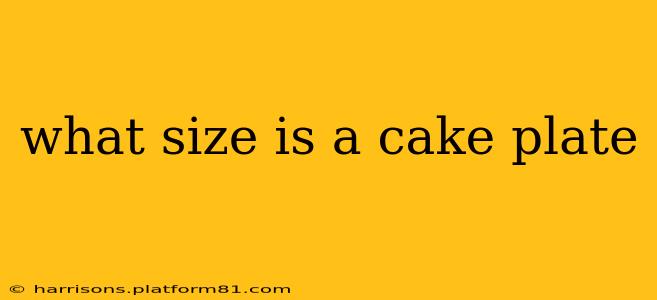What Size is a Cake Plate? A Comprehensive Guide to Choosing the Perfect Serving Platter
Choosing the right cake plate can elevate your dessert presentation from simple to stunning. But with so many sizes and styles available, knowing which one to select can feel overwhelming. This guide will explore the various sizes of cake plates, helping you find the perfect fit for your cake and occasion.
While there isn't one standard "cake plate size," the dimensions are usually dictated by the size of the cake itself. Generally, you want a plate that's slightly larger than the cake's base to provide ample space and prevent the cake from overhanging precariously. This allows for easier serving and a more aesthetically pleasing presentation.
What are the common sizes of cake plates?
Cake plates are available in a wide range of diameters, typically ranging from 6 inches to 20 inches or more. The most common sizes you'll encounter include:
- 6-8 inch cake plates: Ideal for small cakes, cupcakes, or individual desserts. Perfect for intimate gatherings or personal enjoyment.
- 10-12 inch cake plates: A popular choice for standard-sized layer cakes, particularly those serving 6-12 people. These offer a good balance between size and practicality.
- 14-16 inch cake plates: Suitable for larger cakes designed to feed a larger crowd (12-20 people or more). These are often used for celebrations or special events.
- 18-20 inch (and larger) cake plates: These are generally reserved for exceptionally large cakes or for showcasing multiple smaller desserts arranged artistically. They might be used for weddings or other grand events.
What size cake plate do I need for a [specific cake size] cake?
This is a frequently asked question, and the answer depends on the diameter of your cake's base. As a general rule of thumb:
- Add 2-4 inches to the diameter of your cake's base. This extra space provides a visually appealing border and prevents the cake from looking cramped. For instance, a 9-inch cake would ideally sit on an 11-13 inch cake plate.
How to measure your cake for the right plate size?
Measuring your cake accurately is crucial for selecting the right-sized plate. Use a flexible measuring tape to carefully measure the diameter (width) of your cake's base. Remember to measure at the widest point.
What materials are cake plates made from?
Cake plates come in various materials, each with its own advantages:
- Cardboard: Disposable and cost-effective, but not reusable. Suitable for single-use events.
- Paperboard: Similar to cardboard but often sturdier and sometimes decorated. Also disposable.
- Plastic: Durable, lightweight, and easy to clean. Often affordable, but less elegant than other options.
- Glass: Elegant and sophisticated, but can be fragile and heavier than other materials.
- Metal: Durable and sturdy, but can be prone to scratching and may require more care.
- Ceramic: Elegant, durable, and often dishwasher safe, making them a popular choice.
Beyond Size: Considering Other Factors
Beyond the size, you should also consider:
- Style: Choose a plate that complements your cake's design and the overall theme of your event.
- Height: While not always a primary concern, the height of the cake plate can impact presentation. Taller plates can create a more dramatic effect.
- Durability: Choose a plate made from a material that can withstand the weight of your cake and the potential for spills.
By considering these factors, you can confidently choose a cake plate that perfectly complements your cake and enhances the overall presentation, creating a truly memorable dessert experience.
